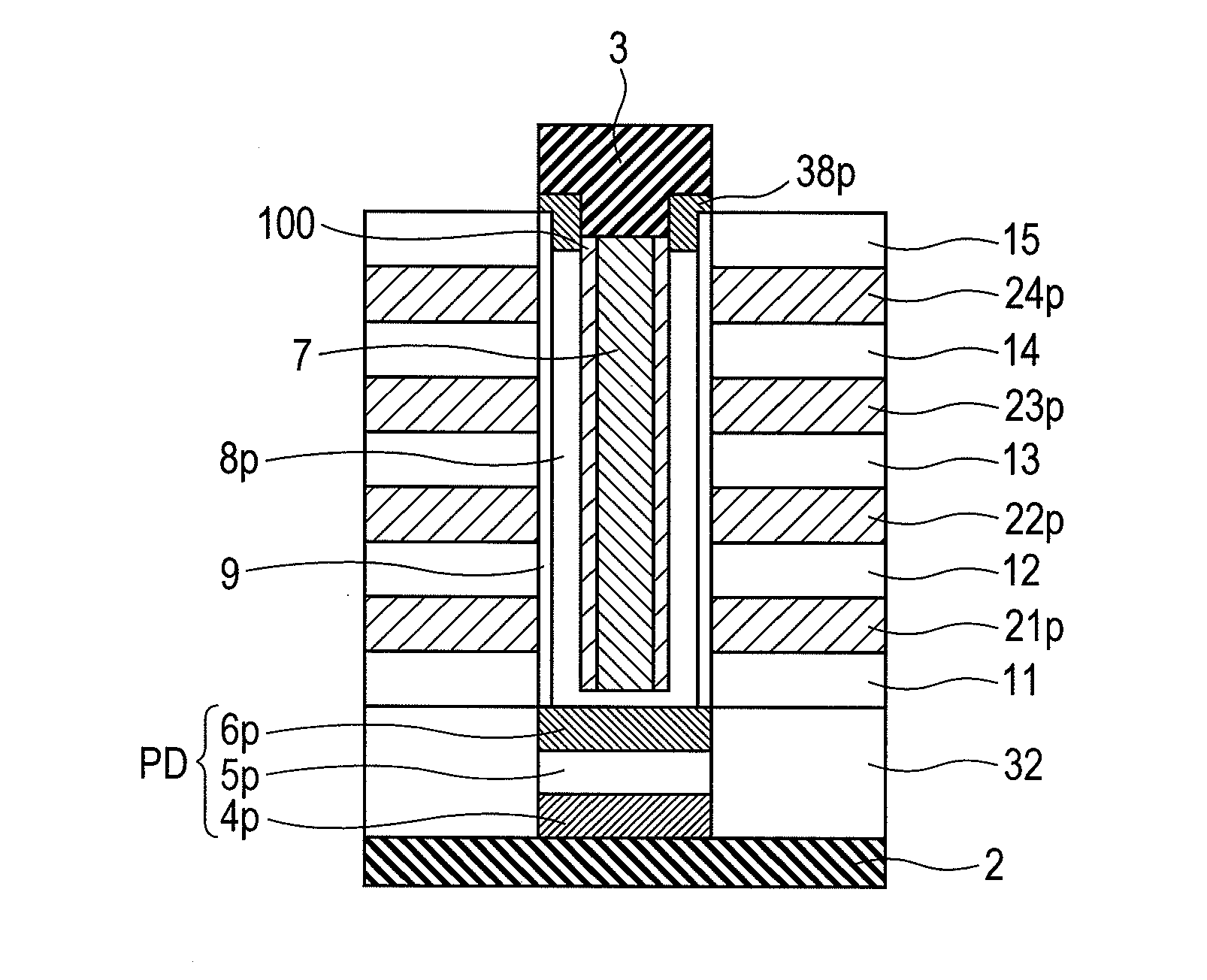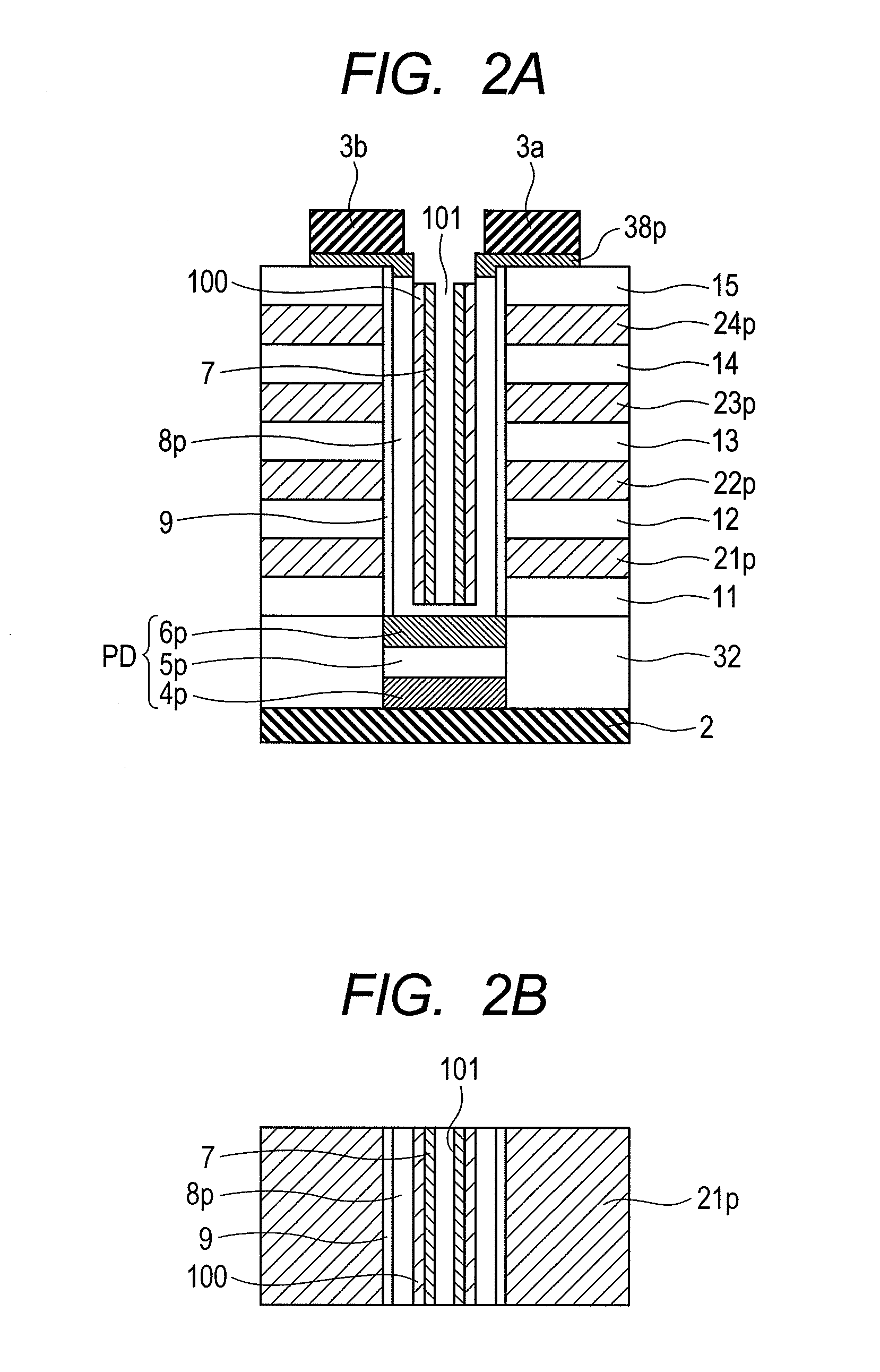Semiconductor memory device
- Summary
- Abstract
- Description
- Claims
- Application Information
AI Technical Summary
Benefits of technology
Problems solved by technology
Method used
Image
Examples
example 1
[0070]FIGS. 1A and 1B show an example of a model of a phase-change memory having a vertical memory structure. FIG. 1A is a cross sectional view in the vertical direction and FIG. 1B is a cross sectional view in a horizontal direction for a portion shown by a reference 21p. The drawing shows a phase-change memory material (phase-change-material layer) 7, an interface layer 100, and a channel polysilicon layer (channel layer) 8p for flowing a write current. Further, gate polysilicon layers (gate layers) 21p, 22p, 23p, and 24p, and insulating film layers (inter-gate-layer insulating films) 11, 12, 13, 14, and 15 are formed alternately, and a channel polysilicon layer 8p, and a phase-change layer are disposed continuously on the lateral sides thereof. That is, the stack has a connection hole that connects the upper surface and the lower surface of the gate polysilicon layers 21p, 22p, 23p and 24p, and the insulating film layers 11, 12, 13, 14, and 15 formed alternately, and the phase-ch...
example 2
[0109]As described above, at the minimum feature size of 32 nm by lithography, the film thickness of the phase-change material was about 4 nm. For proceeding the refinement further, it is necessary for the phase-change material to conduct reversible switching between amorphous and crystalline states at the film thickness of less than 4 nm. It has been generally considered that crystallization becomes difficult and switching operation is no more shown when the thickness of the phase-change material is about 6 nm or less. Then, by utilizing the resistance measurement device described above, the film thickness and the switching characteristics of the phase-change material sandwitched by various interface material films were measured. In this example, a Ge2Sb2Te5 compound material was used as the phase-change material. FIG. 30 to FIG. 32 show the result of measuring the resistivity change from an as deposited amorphous state to a crystalline state in the same manner as described above. ...
example 3
[0129]Then, description is to be made to a recording method of suppressing cross-erase as a second object of the invention. FIG. 36A is a schematic view for the structure shown in FIG. 2A. GP corresponds to a gate poly silicon layer, which is isolated by an insulating film INS. Further, a member X is formed on the side wall of the gate polysilicon layer GP and the insulating film INS in which gate insulating film-channel portion (polysilicon channel)-phase-change material layer-insulating film-phase-change material layer-channel portion (polysilicon channel)-gate insulating film are disposed from the left. For the sake of simplicity of the description, thin interface layer thin film shown in FIG. 2 is not illustrated. In the invention described in Example 3, the interface layer film may or may not be present.
[0130]Then, as the lateral refinement is proceeded, since the aspect ratio becomes greater, the size in the vertical direction is also decreased. Then, a gap between the gate po...
PUM
 Login to View More
Login to View More Abstract
Description
Claims
Application Information
 Login to View More
Login to View More - R&D
- Intellectual Property
- Life Sciences
- Materials
- Tech Scout
- Unparalleled Data Quality
- Higher Quality Content
- 60% Fewer Hallucinations
Browse by: Latest US Patents, China's latest patents, Technical Efficacy Thesaurus, Application Domain, Technology Topic, Popular Technical Reports.
© 2025 PatSnap. All rights reserved.Legal|Privacy policy|Modern Slavery Act Transparency Statement|Sitemap|About US| Contact US: help@patsnap.com



